Family : Scolopacidae

Text © Dr. Gianfranco Colombo

English translation by Mario Beltramini
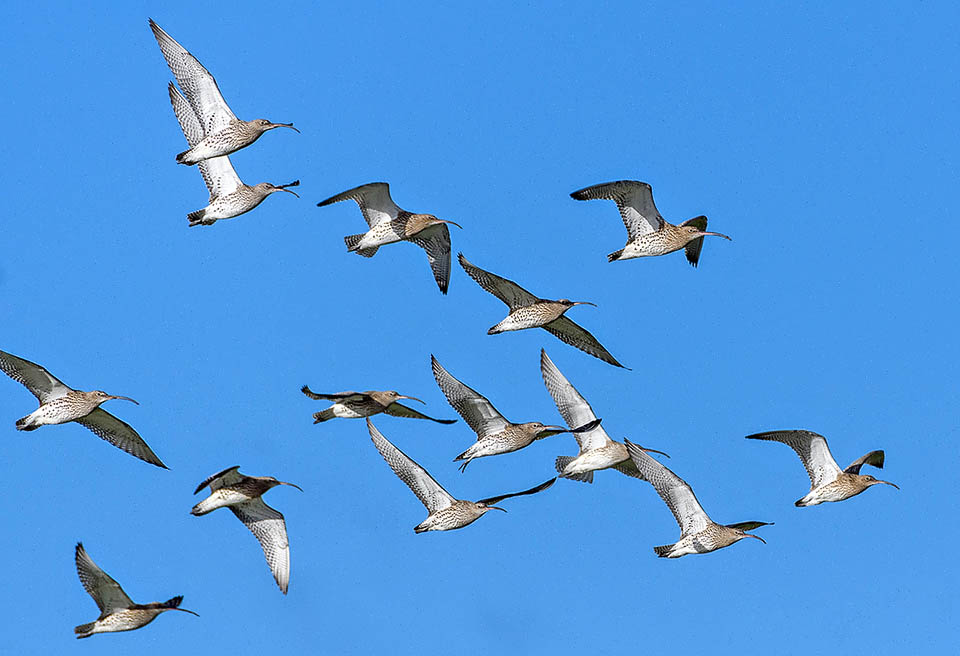
Also in fogs and in difficult conditions of visibility it’s impossible not to recognize a Common curlew (Numenius arquata) © Paul Watts
The Eurasian curlew is a very particular bird and unmistakable for two peculiar characteristics, the first is the very long beak, highly arcuate, anomalous in size and shape but that repeats faithfully that of three peers, though not belonging to the same order as they are classified among the Threskiornithidae, that is the vanishing African sacred ibis (Threskiornis aethiopicus), the Glossy ibis (Plegadis falcinellus), and the very rare Hermit ibis (Geronticus eremita).
The second characteristic is the melodious song verse “chiurlìu chiurlìu” (hence the Italian name of Chiurlo), audible from a considerable distance, and that it emits continuously while flying as well as when on the ground, to keep in touch with its peers or, exasperatedly, when is alone in frantic search for conspecifics.
A quite particular song that in the North-European lands where it nidifies, has been indicated together with that of the Loons, as the “sound of the moorland ”, a melodious moan that pervades the silent and barren northern expanses.
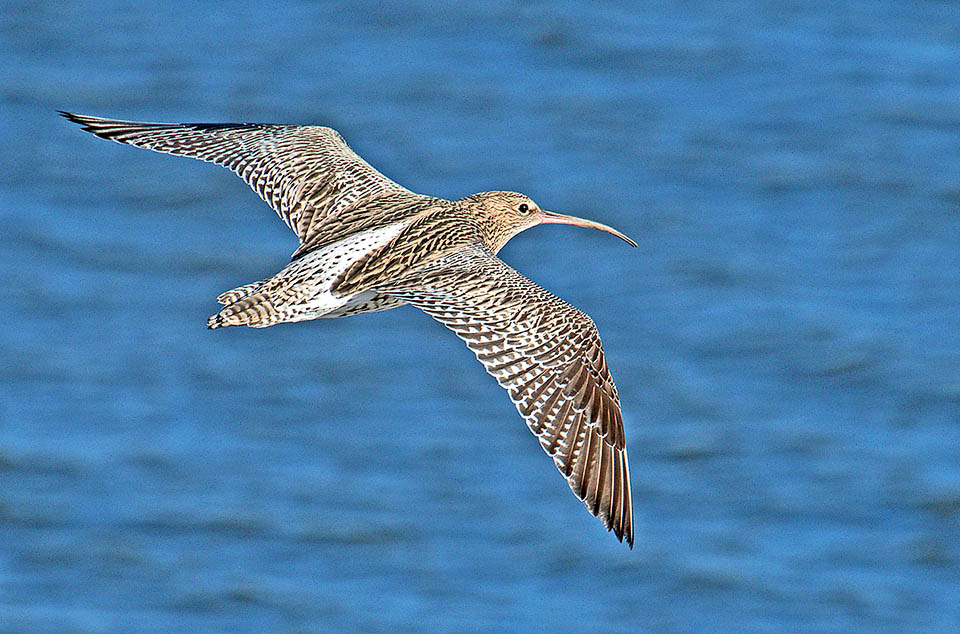
Could be mistaken for the livery but not for that arcuate profile of the beak and the melodious song “chiurlìu chiurlìu” it emits continuously flying as well as on the ground © Jeff Phillips
Actually from the three aforementioned consimilars, it is differentiated aldso for the colour of the livery, if not for the Glossy ibis and partially for the Hermit who, like it, display a dark plumage, modest and inconspicuous.
Moreover, encountering the Hermit ibis, practically extinct in the western world, if not for the artificially reintroduced specimens, is so unlikely as to dispel any doubt.
However, the humid and gloomy environment where the Eurasian curlew lives, the persistent foggy haze that wraps these sites and the potential sharing of the same territories with these consimilars, can inadvertently mislead when is misled only the strange silhouette of this bird and in such case the song gets determinant. Conversely, we shall see how other congeners have remarkable resemblance with our bird.
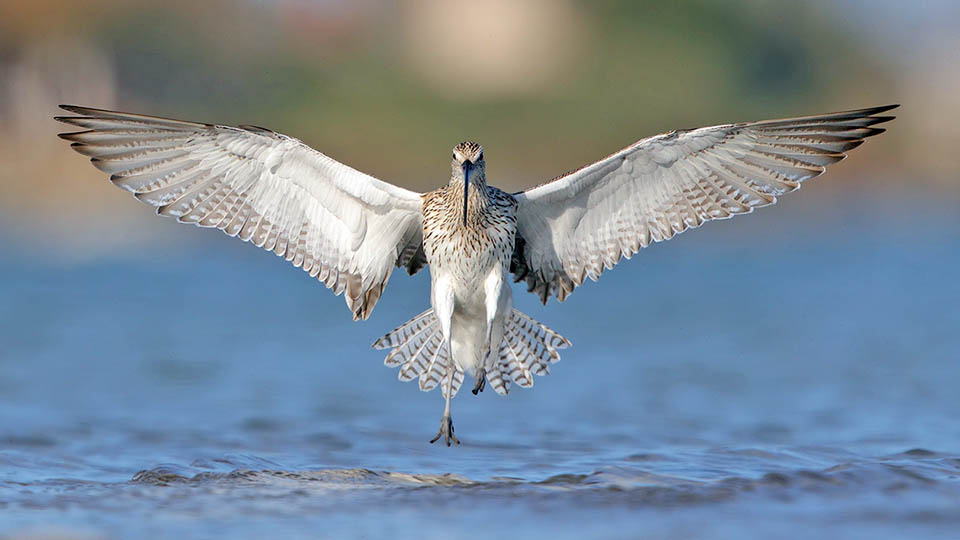
Reaches 60 cm of length, with a weight that in certain periods can amply exceed 1 kg with a wingspan of 110 cm © Levent Göksoy
The Common curlew, or Eurasian curlew, Numenius arquata (Linnaeus, 1758), belongs to the order of the Charadriiformes and to the family of the Scolopacidae and is the biggest European limicolous assigned to this family.
All the vulgar names attributed, in the Italian regions as well as in the European ones, are chiefly onomatopoeic or related to the morphology of this bird. Some dialect forms of the northern Italian region naturally reflect the shape of the beak calling it gradually arcàsa, arcàia, arcagia, becasù, pivierù but also in Europe; besides the official names, have been given various nicknames such as bec crochu, farièu and whaup.
In English it is Eurasian Curlew, in French Courlis cendré, in German Großer Brachvogel, in Spanish, Zarapito Real and in Portuguese Maçarico real.
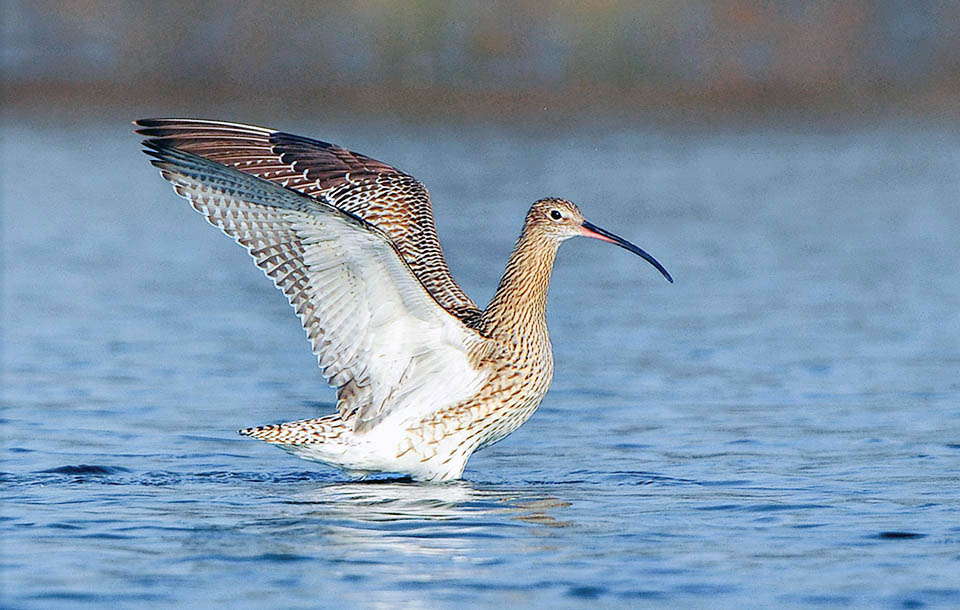
In summer lives in fairly cold environments, in the north Palearctic, but often migrates to the south in winter © Gianfranco Colombo
The etymology of the scientific binomial highlights, as often is the case, what has been the fantasy of the old classifiers. Linnaeus assigned this bid to the genus Scolopax, the same as of the common snipes, so much so that the Common curlew still is placed in the family of the Scolopacidae but Bresson modified later on the genus in Numenius getting the origin from the Greek “noumeenia”, binomial forms by “neos”, new, and “mene”, moon, practically crescent moon, in imitation of the shape of the beak. The specific term arquata originates from the Latin “arcuatus”, shaped like a bow.
Zoogeography
Numenius arquata during the summer occupies rather cool, if not even cold, territories, as it lives in much of Siberia, from Manchuria to the Baltic coasts, the Scandinavian peninsula up to Cape North, Great Britain and Ireland, Holland and Denmark and fragmentarily in some regions of continental Europe, always north of the Alps and of the Pyrenees and almost similarly of the Carpathians.
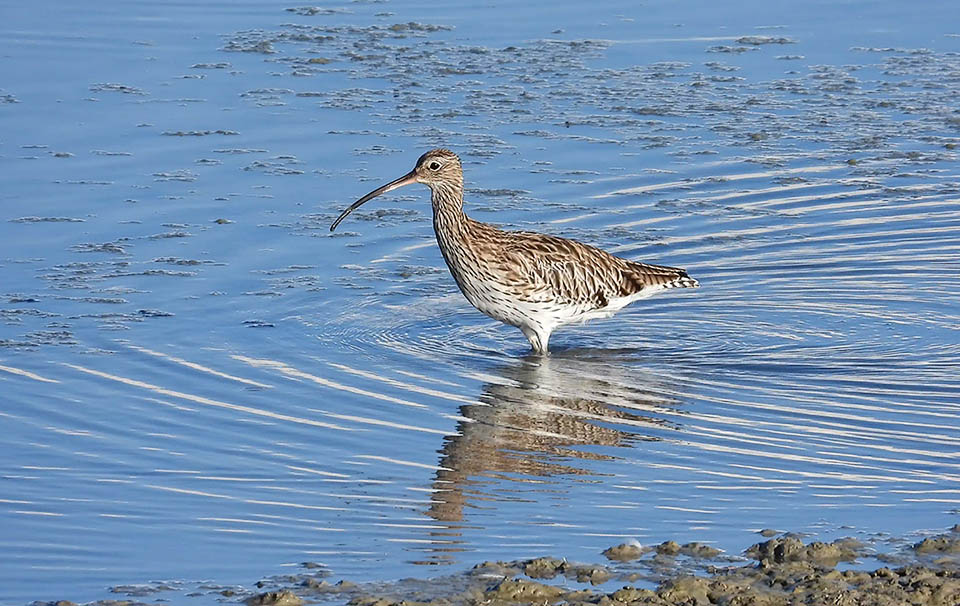
It’s limicolous and as such frequents regularly humid sites, shores of lakes and rivers, marine coasts and wooded meadows © Pierandrea Brichetti
The distribution reaches in the southern part the shores of the Black Sea, those of the Caspian and the lakes of the central Asian republics up to northern Mongolia and Manchuria.
Conversely, the wintering area is very vast. All African coasts, the great lakes and the humid zones both tran-Saharan and southern, Madagascar, the Arabian peninsula, the Indian one and SouthEast Asia and part of Indonesia. Practically all African and Asian coasts up to Japan belong to their wintering areas. It spends the winter also in the Mediterranean basin, in Spain, in Italy, in the Balkan peninsula, in Turkey and on the coasts of North Africa.
In some territories such as Ireland and Great Britain, in part of north France and on all North Sea coast, the Common curlew is in part resident and during the migration the various populations do overlap.
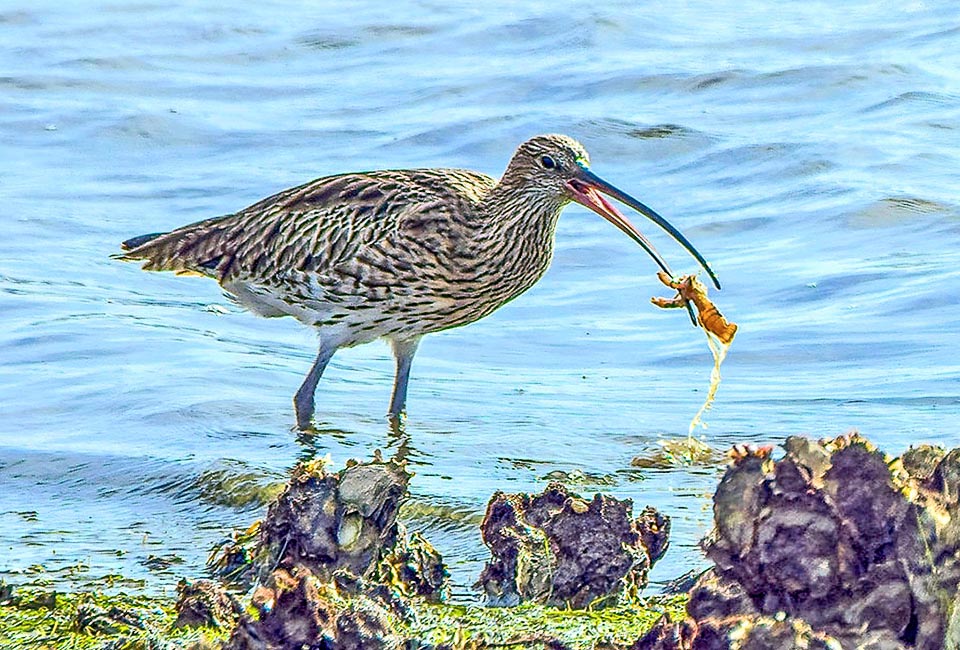
Here has caught a shrimp, but eats also worms, larvae and mollusks sinking beak into the mud, even for 15 cm, where no other limicolous could get © Jesús Sánchez Yagüe
Numenius arquata is a polytypic species with two or three subspecies depending on the taxonomic interpretations. Numenius arquata arquata the holotype that occupies all the European continent, Numenius arquata orientalis, that nidifies from Europe up to Manchuria through Siberia and Numenius arquata suschkini, of the southernmost Asian range, from the central republics up to China not shared by everyone. The Common curlew is therefore, for most of the populations, a long tangr migrant whilst in other instances it performs wanderings without a precise destination, avoiding the harsh climates of the Palearctic winter.
Ecology-Habitat
The Common curlew is limicolous and as such frequents regularly the humid sites, shores of lakes and rivers, sea shores and flooded meadows, but in the meantime frequents even cultivated meadows, farms, moors and tundras. In order to make the best use of its long curved beak, it must find muddy and soft land that may allow it to penetrate the more than 15 cm of this anomalous tool.
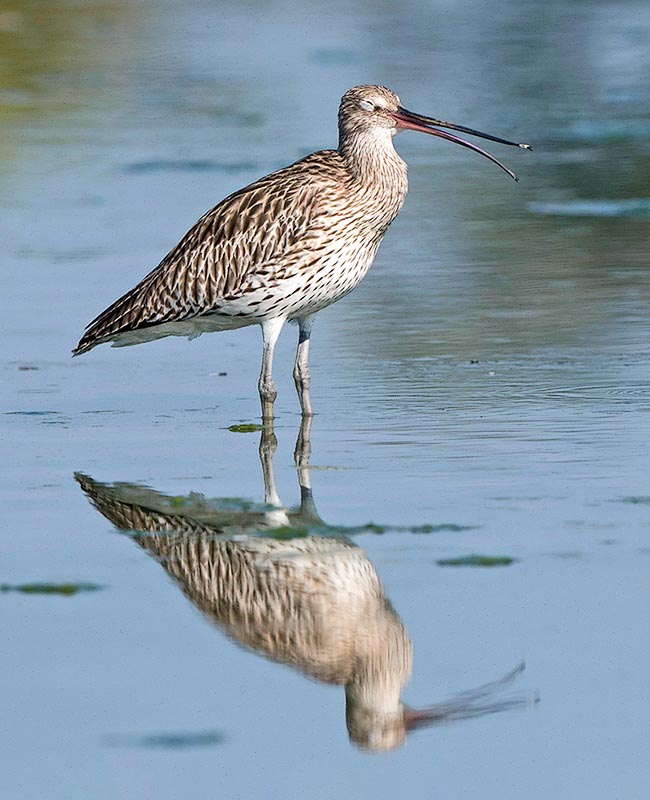
Here stretches the eyelid and the beak, not rigid as we could think and can search anywhere © Gianfranco Colombo
Effectively when the soil has these characteristics, the Common curlew is able to reach depths that no other limicolous can reach, reserving the microfauna it feeds on, in particular worms, crustaceans larvae and mollusks.
Conversely, when on lands of different consistency, here it is, nourishing of various insects, such as grasshoppers, crickets, larvae and chrysalises, using the beak simply for collecting its preys.
In the north of its range, the moor and partially the boreal tundras are its preferred habitat and as aforementioned it is their characteristic and usual inhabitant. It does not love the thick forests and the heavy wooded lands but rather open spaces where it can freely run around and graze and in the meantime observe carefully the surrounding areas.
It does not even like arid soil, dried up lands nor even less high temperatures but, conversely, loves humid climates, rainy and windy, carefully avoiding the strong frost and the snow.
Rightly for this reason during the cold season and in particular for the resident populations or wandering of our continent, it chooses sites not subject to string temperature variations and that are not subject to frosts that would render impossible its sustenance. It is in this period that more than any other time of its life, the Common curlew frequents beaches and maritime shores that guarantee its minimal survival conditions.
Morphology
Numenius arquata is a limicolous of singular dimensions and as said before, is the biggest scolopacid of the Palearctic. It reaches the length of 60 cm, a weight that in some periods may exceed by a large margin the 1000 g with a wingspan of 110 cm.
It has a long, thin and strongly curved bent downwards beak, of flesh green colour, a beak that with age gets increasingly robust and elongated. In the female, slightly bigger than the male, it can reach 18 cm when adult and its greatest length is one of the characters that render possible the distinction between the sexes.
In the juveniles initially the ebak is little curved and shorter by some centimetres, but quickly reaches the right measures. The livery of this bird is not conspicuous.
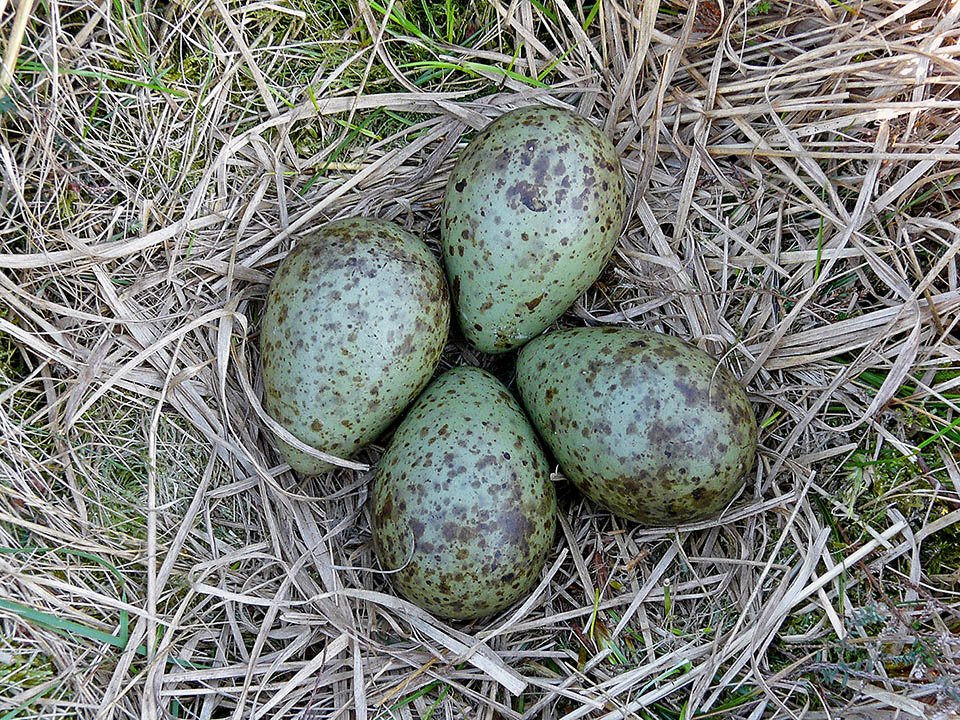
The nest is a small depression in the ground, lined with little material and at times with some feather, where usually are laid 4 eggs © Hero Moorlag
A totally brown cryptic bird plumage like the females of many ducks, with shades paler and scattered over all the wing cover, mottled chest of the same colour, with spots and dottings that gradually getting down from the neck fade until they become, on the sides, arrowhead designs and disappear on the lower abdomen th. is whitish and generally free from any stain.
When flying displays a very evident white rump. Black eyes and long and robust bluish grey legs. The juveniles are rather similar to the adults.
It is a very attentive and suspicious bird and upon the least sign of danger gets intimidated by fleeing quickly, accompanied by its usual moaning.
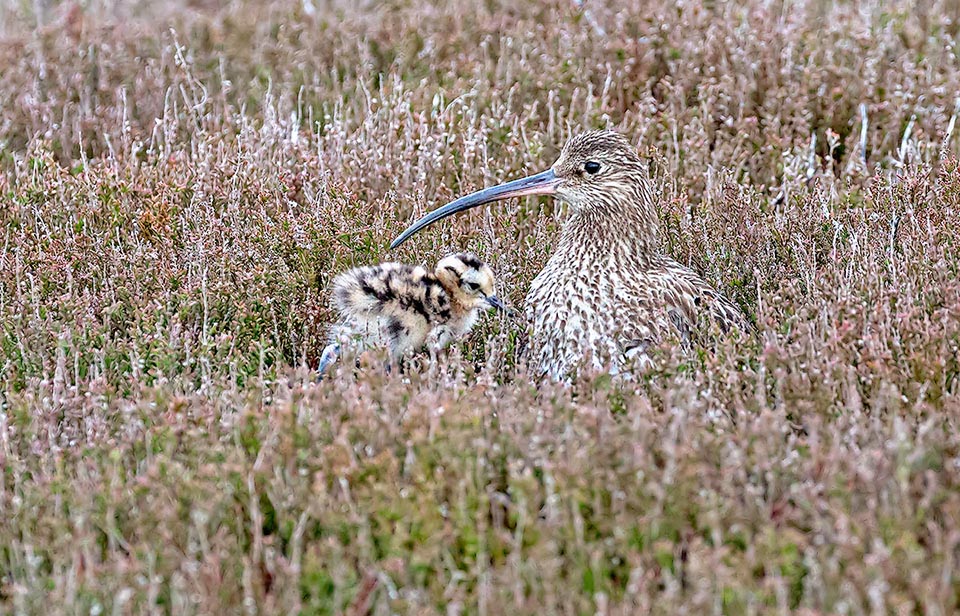
Parent with chick. The brood lasts about one month but at times also the male participates © Jim Greenfield
While resting it is not very social even with its own similars and prefers the couple loneliness though in the feeding sites may momentarily get form small gatherings. Conversely, while migrating or stationing in the winter quarters, can form flocks of several hundred specimens that later on dissolve when the nesting time comes.
Besides the Common curlew, in the Palearctic are present two other congeners quite similar that may mislead even experienced naturalists when observed alone.
The Small curlew (Numenius phaeopus) as the name says is noticeably smaller than the larger one and differs for some blackish streaks on the head.
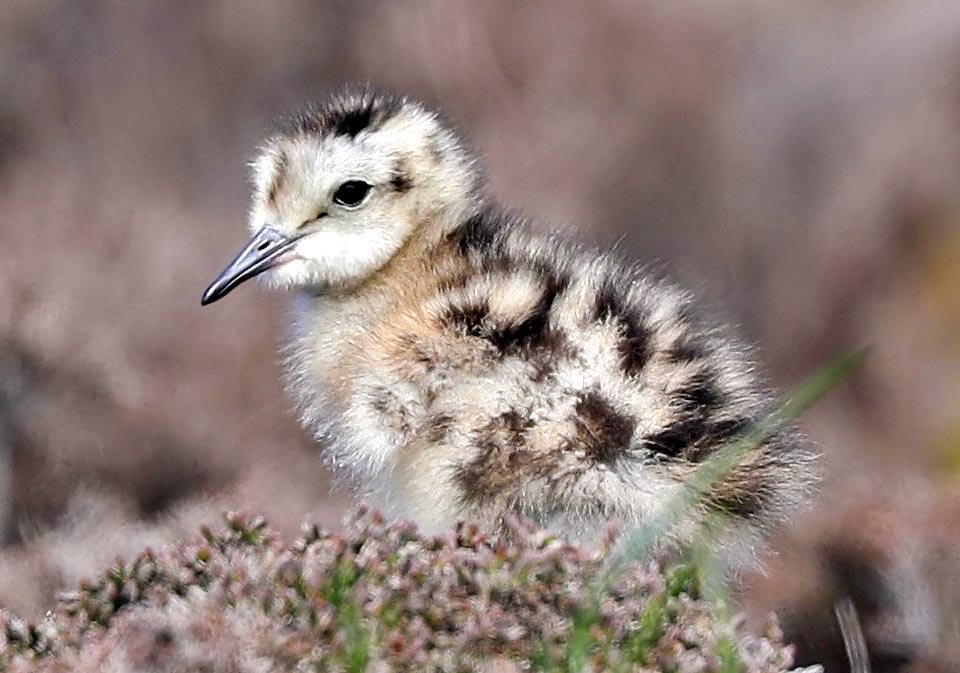
Just after birth the chicks of Numenius arquata leave the nest and disperse in the surroundings © Sonia Johnson
There is then the Slender-billed curlew (Numenius tenuirostris) quite similar to the latter but practically impossible to find, as the last sighting dates back to about twenty years ago and finding it would mean to resurrect it and give a confirmation to its present and doubted existence.
There are then other species of the Far East and of North America with a morphology almost similar to our Common curlew among which the very rare Eskimo curlew (Numenius borealis), nowadays reported as on the verge of extinction.
The others are the Little curlew (Numenius minutus), the Bristle-thighed curlew (Numenius tahitiensis), the Long-billed curlew (Numenius americanus) and the Far Eastern curlew (Numenius madagascariensis) erroneously called of Madagascar but present only in and around Australia. The last two have exceptionally oversized beaks elongating between 21 and 23 cm of length!
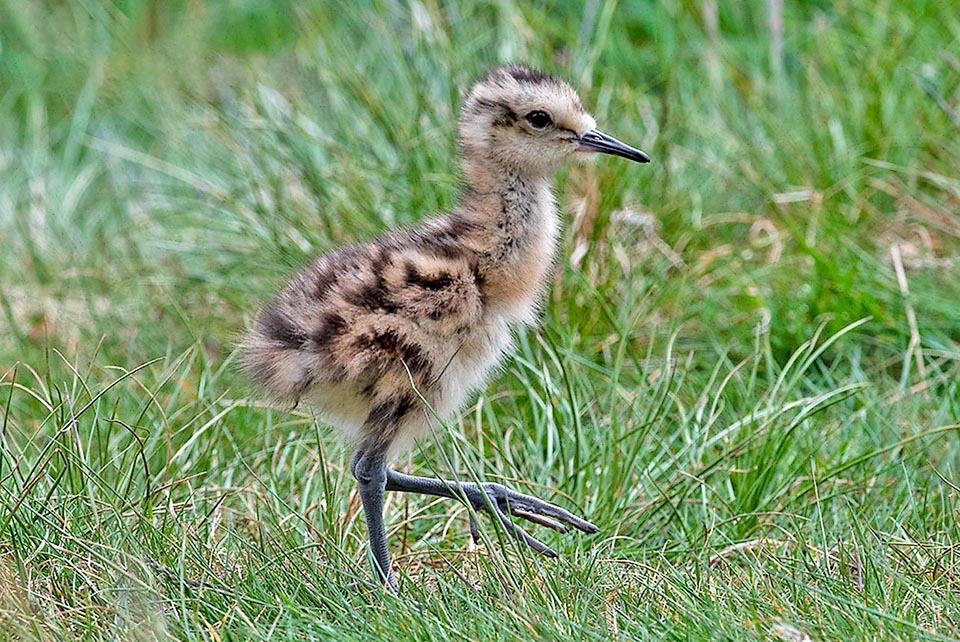
They are already self-sufficient in feeding but are cared for long time by parents until when they are able to fly © Tim Coleman
Ethology-Reproductive Biology
The nest of Numenius arquata is a small depression on the ground lined with little material and sometimes also with some feathers. The male digs a series of small depressions on the soil, always in a dry location and generally behind tufts of grass or of heather that it partially shelters them on one side, leaving the choice to the female who provides to complete the construction carrying there some material.
The eggs are big and markedly oval, of olive colour with blackish and reddish specklings, such to render them fairly camouflaged with the surrounding environment. On average 4 eggs are laid and are incubated for about one month, usually by the female but also by the male who in some instances equally takes charge of the task.
Hatching is synchronous and immediately after the birth the chicks leave the nest and disperse in the surrounding area cared for by both parents. They are already self-sufficient in nutrition but for a long time they are cared for by the adults until when they are able to fly.
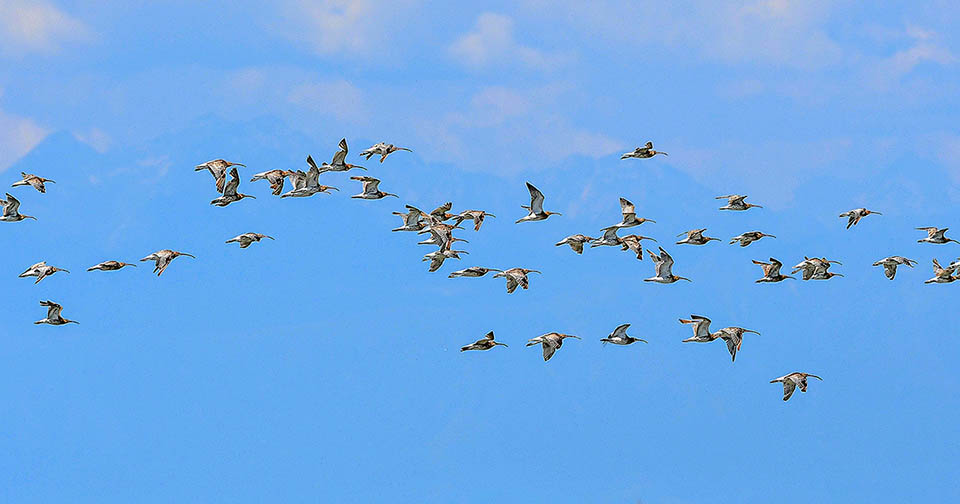
Art times the Common curlew is a long range migrant, up to Madagascar, whilst in other cases moves and wanders without a precise destination © Gianfranco Colombo
Maturity is reached in the second year and it is thought that the Common curlew has an average life that may exceed ten years.
The flesh of this bird has always been appreciated since the Middle Ages and is still now subject of hunting for habitual consumption. We read that in Great Britain the flesh of Common curlew was a major market item and that unti lt second world war it could be easily purchased at any butcher. However now in various sites the populations are decreasing and it appears as “Near Threatened” in the IUCN Red List of the endangered species.
Returning to the plaintive song of the Common curlew and the inspiration that such a sweet sound has left since the remote times, we have to remember what is immortalized in an old English poem of X century that recalled how romantic and pleasant was to hear this song: “I get more happiness in hearing the song of the Common curlew…. than from the laughter of men”.
Synonyms
Scolopax arquata Linnaeus 1758.
→ For general information about the Charadriiformes please click here.
→ To appreciate the biodiversity within the CHARADRIIFORMES please click here.
